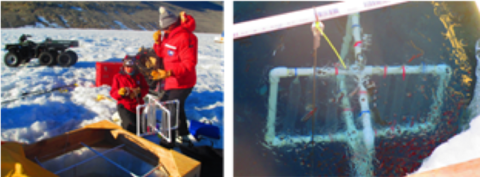
tLICE was designed to consider the impact of increased connectivity between MCM landscapes on community stability. Natural planktonic communities of Lakes Bonney (east lobe) and Fryxell collected from either the liquid moats or the under-ice communities are transferred to dialysis bags and suspended in the water column at various locations. During the 2017/18 field season, microbial communities from the water column of Lake Bonney (east lobe) under the permanent ice were transplanted in two experiments: i) communities representing three major phytoplankton peaks were transplanted 3 m deeper into the water column to mimic 2 decades of lake level rise, and ii) shallow (5 m) communities were transplanted into the open water moat to mimic increased connectivity from expanding moats.
The tLICE experiment tests the resistance and resilience of the lake communities (H4) to pulse disturbance of expanding moats causing increased lake connectivity (i.e., transplanted moat communities) and the press disturbance of lake level rise (i.e., shallow to deep transplanted communities). Following 2 weeks incubation, we successfully retrieved the transplanted communities and measured i) changes in phytoplankton community diversity and function using variable chlorophyll a fluorescence (Phyto PAM, Walz), ii) dissolved organic carbon quality (excitation emission fluorescence matrices), and iii) bacterial and eukaryal community structure (16S and 18S rRNA amplicon sequencing).
Phytoplankton communities residing in the shallow (5 m), chemocline (17 m) and deep (23 m) layers of the photic zone exhibited differential sensitivity to the environmental disturbances. Phytoplankton from the shallow, oligotrophic zone (5 m) exhibited significant changes in community biomass and phytoplankton community composition. In contrast, phytoplankton communities from the chemocline (17 m) or deep photic zone (23 m) were less sensitive to the transplant. Similarly, bacterial and eukaryal communities residing in the shallow zone exhibited significant shifts in community structure, while deep communities were not affected by the disturbance; however, the response of the two communities was asynchronous. Bacterial communities were more sensitive to the moat transplant, while eukaryote communities were impacted by lake level rise.
